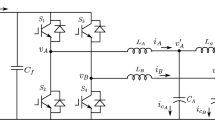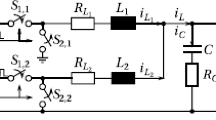Abstract
One of the main objectives of the latest advanced current mode control (CMC) methods for power electronics converters is eliminating error between the average value of the inductor current and the reference current over each switching period, in steady and transient state. A special attention is devoted to the \(I^{2}\) average current mode control (\(I^{2}\) ACMC) method, which ensures both accurate current tracking and fast dynamic response. A new application of the \(I^{2}\) concept on dual current mode control (DCMC) method is introduced in this paper. A detailed analysis of the proposed \(I^{2}\) DCMC is performed for two-quadrant (2Q) buck converter, but it can be extended to any type of converter. The obtained simulation and experimental results confirm the performed analysis and demonstrate excellent features of the proposed \(I^{2}\) DCMC method.










Similar content being viewed by others
References
Erickson RW, Maksimović D (2001) Fundamentals of power electronics. Kluwer Academic Publishers, Boston
Dixon L (1990) Average current mode control of switching power supplies. Texas Instruments Incorporated, Unitrode Power Supply Design Seminar SEM700, Topic 5, SLUP091, pp 1–14
Morales-Saldana JA, Leyva-Ramos J, Carbajal-Gutierrez EE, Ortiz-Lopez MG (2008) Average current-mode control scheme for a quadratic buck converter with a single switch. IEEE Trans Power Electron 23:485–490. https://doi.org/10.1109/TPEL.2007.910907
Yan Y, Lee FC, Mattavelli P (2013) Analysis and design of average current mode control using a describing-function-based equivalent circuit model. IEEE Trans Power Electron 28:4732–4741. https://doi.org/10.1109/TPEL.2012.2235085
Redl R (1991) Small-signal high-frequency analysis of the free-running current-mode-controlled converter. In: IEEE power electronics specialists conference, Cambridge, MA, USA, pp 897–906. https://doi.org/10.1109/PESC.1991.162782
Gautam S, Gupta R (2013) Unified time-domain formulation of switching frequency for hysteresis current controlled AC/DC and DC/AC grid connected converters. IET Power Electron 6:683–692. https://doi.org/10.1049/iet-pel.2012.0484
Zhou C, Ridley RB, Lee FC (1990) Design and analysis of a hysteretic boost power factor correction circuit. In: IEEE power electronics specialists conference, San Antonio, TX, USA, pp 800-807. https://doi.org/10.1109/PESC.1990.131271
Qiu Y, Liu H, Chen X (2010) Digital average current-mode control of PWM DC-DC converters without current sensors. IEEE Trans Industr Electron 57:1670–1677. https://doi.org/10.1109/TIE.2009.2032130
Buso S, Caldognetto T (2015) A nonlinear wide-bandwidth digital current controller for DC–DC and DC–AC converters. IEEE Trans Industr Electron 62:7687–7695. https://doi.org/10.1109/TIE.2015.2465351
Khazraei M, Ferdowsi M (2013) Modeling and analysis of projected cross point control—a new current-mode-control approach. IEEE Trans Industr Electron 60:3272–3282. https://doi.org/10.1109/TIE.2012.2201429
Hsu SS, Brown A, Rensink L, Middlebrook RD (1979) Modeling and analysis of switching DC-to-DC converters in constant-frequency current programmed mode. In: IEEE power electronics specialists conference, San Diego, CA, USA, pp 284–301. https://doi.org/10.1109/PESC.1979.7081037
Kondrath N, Kazimierczuk MK (2012) Unified model to derive control-to-output transfer function of peak current-mode-controlled pulse-width modulated DC–DC converters in continuous conduction mode. IET Power Electron 5:1706–1713. https://doi.org/10.1049/iet-pel.2012.0147
Sheehan R (2011) Current-mode modeling for peak, valley and emulated control methods. National Semiconductor reference guide, SNVA542, pp 1–94
Lale S, Šoja M, Lubura S (2016) A modified dual current mode control method with an adaptive current bandwidth. Int J Circuit Theory Appl 44:1494–1513. https://doi.org/10.1002/cta.2174
Anunciada AV, Silva MM (1991) A new current mode control process and applications. IEEE Trans Power Electron 6:601–610. https://doi.org/10.1109/63.97758
Chu GML, Lu DDC, Agelidis VG (2012) Practical application of valley current mode control in a flyback converter with a large duty cycle. IET Power Electron 5:552–560. https://doi.org/10.1049/iet-pel.2011.0225
Yan Y, Lee FC, Mattavelli P, Liu PH (2014) \(I^{2}\) average current mode control for switching converters. IEEE Trans Power Electron 29:2027–2036. https://doi.org/10.1109/TPEL.2013.2265381
He S, Hung JY, Nelms RM (2016) Small-signal modeling of \(I^{2}\) average current mode control. IEEE Trans Power Electron 31:3849–3858. https://doi.org/10.1109/TPEL.2015.2459912
Li R, Seto K, Kiefer J, Li S (2016) Analysis, simulation and experimental evaluation of constant-frequency trailing-edge-modulated \(I^{2}\) average current-mode control. In: IEEE international power electronics and motion control conference IPEMC-ECCE Asia, Hefei, P. R. China, pp 2077–2084. https://doi.org/10.1109/IPEMC.2016.7512617
Lachichi A, Pierfederici S, Martin JP, Davat B (2008) Study of a hybrid fixed frequency current controller suitable for DC–DC applications. IEEE Trans Power Electron 23:1437–1448. https://doi.org/10.1109/TPEL.2008.920884
Author information
Authors and Affiliations
Corresponding author
Rights and permissions
About this article
Cite this article
Lale, S., Šoja, M., Lubura, S. et al. Application of \(I^{2}\) technique on dual current mode control of power electronics converters. Electr Eng 100, 1761–1772 (2018). https://doi.org/10.1007/s00202-017-0653-9
Received:
Accepted:
Published:
Issue Date:
DOI: https://doi.org/10.1007/s00202-017-0653-9




